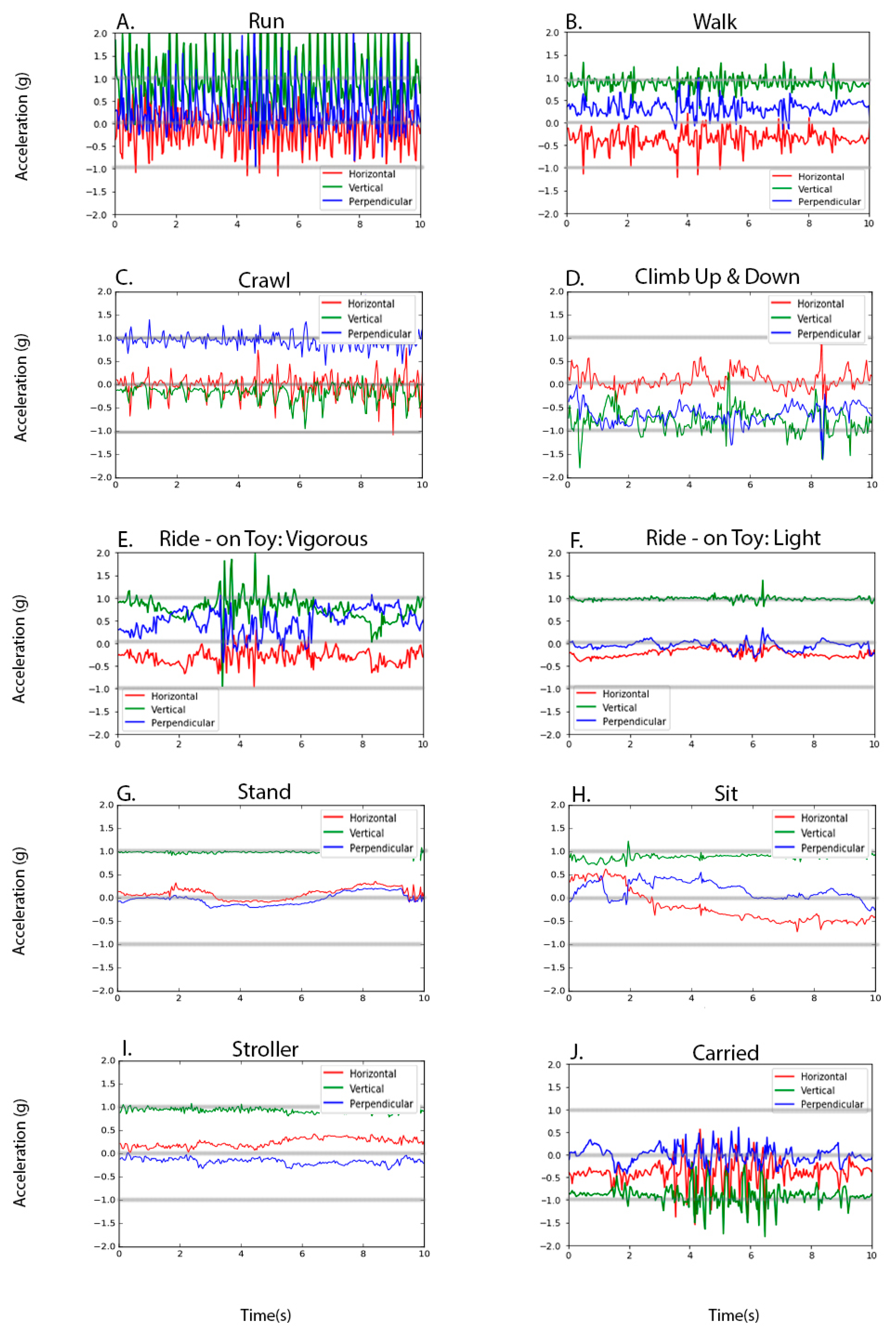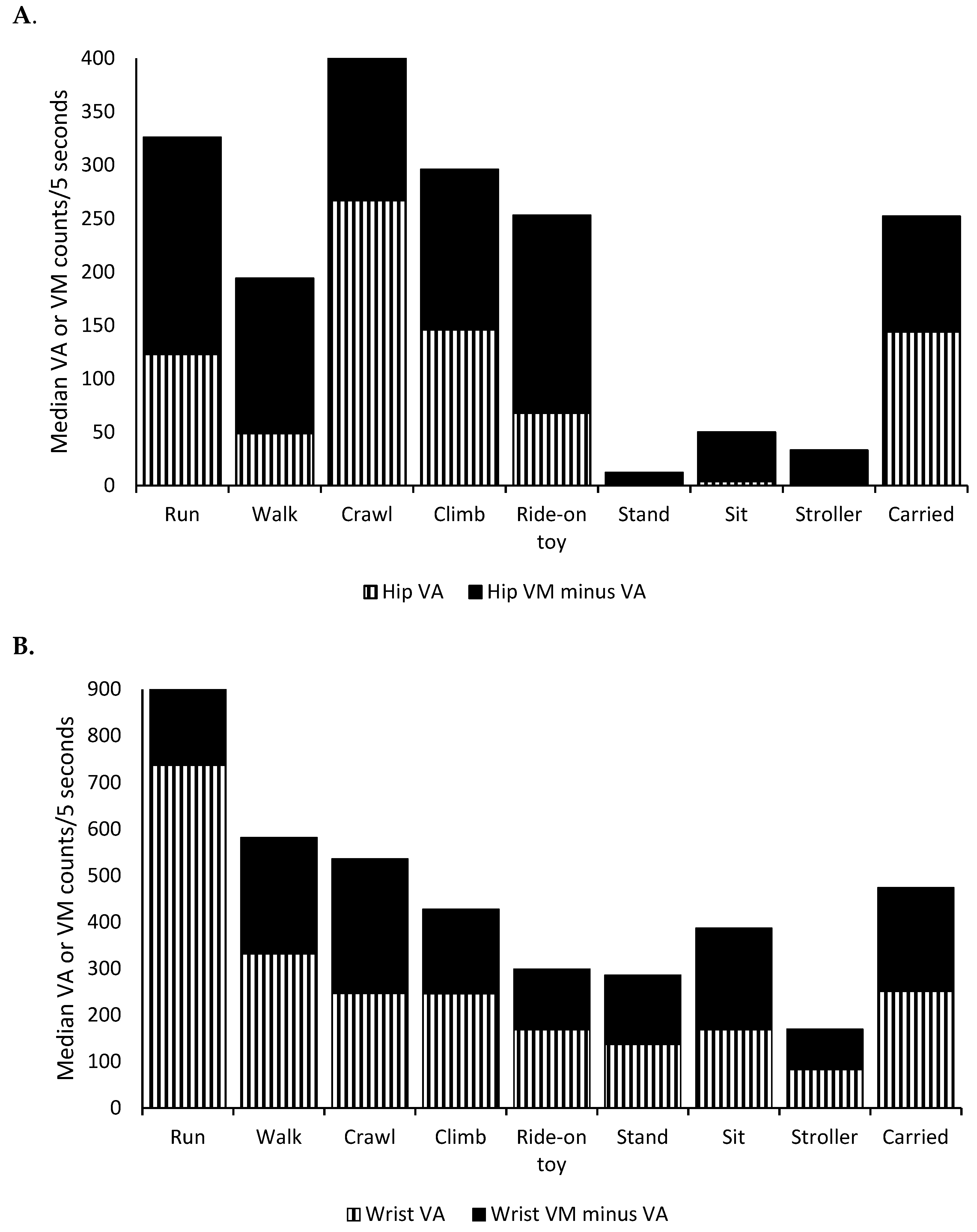Hip and Wrist-Worn Accelerometer Data Analysis for Toddler Activities
Abstract
1. Introduction
2. Materials and Methods
2.1. Participants
2.2. Data Collection
2.3. Behavior Labeling
2.4. Accelerometer Data Processing
2.5. Statistical Analysis
3. Results
3.1. Sub-Aim One
3.2. Sub-Aim Two
4. Discussion
5. Conclusions
Supplementary Materials
Author Contributions
Funding
Conflicts of Interest
References
- Physical Activity Guidelines Advisory Committee. 2018 Physical Activity Guidelines Advisory Committee Scientific Report; U.S. Department of Health and Human Services: Washington, DC, USA, 2018.
- Kwon, S.; Janz, K.; Letuchy, E.; Trudy, B.; Steven, L. Developmental trajectories of physical activity, sports, and television viewing during childhood to young adulthood. JAMA Pediatr. 2015, 169, 666–672. [Google Scholar] [CrossRef] [PubMed]
- Hinkley, T.; Salmon, J.; Okely, A.D.; Crawford, D.; Hesketh, K. Preschoolers’ physical activity, screen time, and compliance with recommendations. Med. Sci. Sports Exerc. 2012, 44, 458–465. [Google Scholar] [CrossRef] [PubMed]
- Beets, M.W.; Bornstein, D.; Dowda, M.; Pate, R.R. Compliance with national guidelines for physical activity in U.S. preschoolers: Measurement and interpretation. Pediatrics 2011, 127, 658–664. [Google Scholar] [CrossRef] [PubMed]
- Pate, R.R.; O’Neill, J.R.; Brown, W.H.; Pfeiffer, K.A.; Dowda, M.; Addy, C.L. Prevalence of Compliance with a New Physical Activity Guideline for Preschool-Age Children. Child. Obes. 2015, 11, 415–420. [Google Scholar] [CrossRef] [PubMed]
- Worobey, J. Physical activity in infancy: Developmental aspects, measurement, and importance. Am. J. Clin. Nutr. 2014, 99, 729S–733S. [Google Scholar] [CrossRef] [PubMed]
- Costa, S.; Barber, S.E.; Cameron, N.; Clemes, S.A. The objective measurement of physical activity and sedentary behaviour in 2–3 year olds and their parents: A cross-sectional feasibility study in the bi-ethnic Born in Bradford cohort. BMC Public Health 2015, 15, 1109. [Google Scholar] [CrossRef] [PubMed]
- Hnatiuk, J.; Ridgers, N.D.; Salmon, J.; Campbell, K.; McCallum, Z.; Hesketh, K. Physical activity levels and patterns of 19-month-old children. Med. Sci. Sports Exerc. 2012, 44, 1715–1720. [Google Scholar] [CrossRef] [PubMed]
- Borkhoff, C.M.; Heale, L.D.; Anderson, L.N.; Tremblay, M.S.; Maguire, J.L.; Parkin, P.C.; Birken, C.S. Objectively measured physical activity of young Canadian children using accelerometry. Appl. Physiol. Nutr. Metab. 2015, 40, 1302–1308. [Google Scholar] [CrossRef] [PubMed]
- Lee, E.Y.; Hesketh, K.D.; Rhodes, R.E.; Rinaldi, C.M.; Spence, J.C.; Carson, V. Role of parental and environmental characteristics in toddlers’ physical activity and screen time: Bayesian analysis of structural equation models. Int. J. Behav. Nutr. Phys. Act. 2018, 15, 17. [Google Scholar] [CrossRef]
- Hager, E.R.; Gormley, C.E.; Latta, L.W.; Treuth, M.S.; Caulfield, L.E.; Black, M.M. Toddler physical activity study: Laboratory and community studies to evaluate accelerometer validity and correlates. BMC Public Health 2016, 16, 936. [Google Scholar] [CrossRef]
- Kuzik, N.; Clark, D.; Ogden, N.; Harber, V.; Carson, V. Physical activity and sedentary behaviour of toddlers and preschoolers in child care centres in Alberta, Canada. Can. J. Public Health 2015, 106, e178–e183. [Google Scholar] [CrossRef] [PubMed]
- Raza, H.; Zhou, S.M.; Todd, C.; Christian, D.; Marchant, E.; Morgan, K.; Khanom, A.; Hill, R.; Lyons, R.A.; Brophy, S. Predictors of objectively measured physical activity in 12-month-old infants: A study of linked birth cohort data with electronic health records. Pediatr. Obes. 2019, 14, e12512. [Google Scholar] [CrossRef] [PubMed]
- Trost, S.G.; Fees, B.S.; Haar, S.J.; Murray, A.D.; Crowe, L.K. Identification and validity of accelerometer cut-points for toddlers. Obesity 2012, 20, 2317–2319. [Google Scholar] [CrossRef]
- Oftedal, S.; Bell, K.L.; Davies, P.S.; Ware, R.S.; Boyd, R.N. Validation of accelerometer cut points in toddlers with and without cerebral palsy. Med. Sci. Sports Exerc. 2014, 46, 1808–1815. [Google Scholar] [CrossRef] [PubMed]
- Ellis, K.; Kerr, J.; Godbole, S.; Staudenmayer, J.; Lanckriet, G. Hip and Wrist Accelerometer Algorithms for Free-Living Behavior Classification. Med. Sci. Sports Exerc. 2016, 48, 933–940. [Google Scholar] [CrossRef] [PubMed]
- Nam, Y.; Park, J.W. Child activity recognition based on cooperative fusion model of a triaxial accelerometer and a barometric pressure sensor. IEEE J. Biomed. Health Inform. 2013, 17, 420–426. [Google Scholar] [PubMed]
- Zhao, W.; Adolph, A.L.; Puyau, M.R.; Vohra, F.A.; Butte, N.F.; Zakeri, I.F. Support vector machines classifiers of physical activities in preschoolers. Physiol. Rep. 2013, 1, e00006. [Google Scholar] [CrossRef] [PubMed]
- Trost, S.G.; Cliff, D.P.; Ahmadi, M.N.; Tuc, N.V.; Hagenbuchner, M. Sensor-enabled Activity Class Recognition in Preschoolers: Hip versus Wrist Data. Med. Sci. Sports Exerc. 2018, 50, 634–641. [Google Scholar] [CrossRef]
- Hagenbuchner, M.; Cliff, D.P.; Trost, S.G.; Van, T.N. Peoples GE. Prediction of activity type in preschool children using machine learning techniques. J. Sci. Med. Sport 2015, 18, 426–431. [Google Scholar] [CrossRef]
- John, D.; Freedson, P. ActiGraph and Actical physical activity monitors: A peek under the hood. Med. Sci. Sports Exerc. 2012, 44, S86–S89. [Google Scholar] [CrossRef]
- Kerr, J.; Patterson, R.E.; Ellis, K.; Godbole, S.; Johnson, E.; Lanckriet, G.; Staudenmayer, J. Objective Assessment of Physical Activity: Classifiers for Public Health. Med. Sci. Sports Exerc. 2016, 48, 951–957. [Google Scholar] [CrossRef] [PubMed]
- Vanloo, C.M.; Okely, A.D.; Batterham, M.J.; Hinkley, T.; Ekelund, U.; Brage, S.; Reilly, J.J.; Trost, S.G.; Jones, R.A.; Janssen, X.; et al. Wrist Accelerometer Cut Points for Classifying Sedentary Behavior in Children. Med. Sci. Sports Exerc. 2017, 49, 813–822. [Google Scholar] [CrossRef] [PubMed]
- Kim, Y.; Lee, J.M.; Peters, B.P.; Gaesser, G.A.; Welk, G.J. Examination of different accelerometer cut-points for assessing sedentary behaviors in children. PLoS ONE 2014, 9, e90630. [Google Scholar] [CrossRef] [PubMed]
- Chandler, J.; Beets, M.; Saint-Maurice, P.; Weaver, R.; Cliff, D.; Drenowatz, C.; Moore, J.B.; Sui, M.; Brazendale, K. Wrist-Based Accelerometer Cut-Points to Identify Sedentary Time in 5–11-Year-Old Children. Children 2018, 5, 137. [Google Scholar] [CrossRef] [PubMed]
- Trost, S.G.; Way, R.; Okely, A.D. Predictive validity of three ActiGraph energy expenditure equations for children. Med. Sci. Sports Exerc. 2006, 38, 380–387. [Google Scholar] [CrossRef] [PubMed]
- Freedson, P.S.; Melanson, E.; Sirard, J. Calibration of the Computer Science and Applications, Inc. accelerometer. Med. Sci. Sports Exerc. 1998, 30, 777–781. [Google Scholar] [CrossRef] [PubMed]
- Pate, R.R.; O’Neill, J.R.; Mitchell, J. Measurement of physical activity in preschool children. Med. Sci. Sports Exerc. 2010, 42, 508–512. [Google Scholar] [CrossRef] [PubMed]
- Trost, S.G.; Loprinzi, P.D.; Moore, R.; Pfeiffer, K.A. Comparison of Accelerometer Cut-points for Predicting Activity Intensity in Youth. Med. Sci. Sports Exerc. 2011, 43, 1360–1368. [Google Scholar] [CrossRef]
- Evenson, K.R.; Catellier, D.J.; Gill, K.; Ondrak, K.S.; McMurray, R.G. Calibration of two objective measures of physical activity for children. J. Sports Sci. 2008, 26, 1557–1565. [Google Scholar] [CrossRef]


| Behavior | Description | Frequency | Accelerometer Data in Seconds |
|---|---|---|---|
| n | Mean (Median) | ||
| Run | Running forward from one place to the other. | 20 | 7.5 (5.0) |
| Walk | Walking forward from one place to the other. Taking a few side steps to grab something, for example, was not considered as “walk.” | 244 | 7.3 (6.0) |
| Crawl | Moving forward on two hands and two knees to the ground | 29 | 6.8 (5.0) |
| Climb | Walking up or down the stairs or a soft foam climber | 47 | 8.3 (8.0) |
| Ride-on toy | Sitting on a ride-on toy and moving forward using two feet. Sitting without moving forward or sitting and being pushed by an adult, for example, was not considered as “ride-on toy.” | 40 | 10.3 (10.7) |
| Stand | Standing still without lifting a foot. Moving in place was not considered “standing” | 129 | 6.9 (5.0) |
| Sit * | Sitting on the ground for play such as block play. Sitting on a ride-on toy or a slide, for example, was not considered as “sit.” | 84 | 14.5 (9.5) |
| Stroller | Sitting on a stroller or wagon while it is being pushed by an adult | 36 | 12.0 (10.5) |
| Carried | Being held by an adult while the adult is walking. Being held by an adult without walking was not considered as “carried.” | 35 | 9.9 (14.0) |
| Hip Vertical Counts | Hip Vector Magnitudes | Wrist Vertical Counts | Wrist Vector Magnitudes | |
|---|---|---|---|---|
| Estimate ± SE | Estimate ± SE | Estimate ± SE | Estimate ± SE | |
| Run | 145 ± 14 ** | 352 ± 24 ** | 774 ± 41 ** | 1178 ± 62 ** |
| Walk | 52 ± 12 | 191 ± 21 | 345 ± 37 | 596 ± 55 |
| Crawl | 241 ± 14 ** | 410 ± 24 ** | 247 ± 42 | 528 ± 64 |
| Climb | 169 ± 13 ** | 324 ± 22 ** | 249 ± 38 | 432 ± 57 * |
| Ride-on toy | 100 ± 13 ** | 297 ± 22 ** | 182 ± 39 ** | 308 ± 58 ** |
| Stand | 1 ± 12 ** | 19 ± 21 ** | 121 ± 37 ** | 264 ± 55 ** |
| Sit | 8 ± 12 * | 65 ± 21 ** | 189 ± 37 ** | 388 ± 55 ** |
| Stroller | 7 ± 13 * | 57 ± 22 ** | 116 ± 38 ** | 251 ± 57 ** |
| Carried | 149 ± 14 ** | 258 ± 23 * | 289 ± 40 | 519 ± 60 |
| Rank | Feature | D’ | Feature | Feature Importance |
|---|---|---|---|---|
| 1 | FFT SD of z | 0.64 | SD of VM | 0.039 |
| 2 | z FFT max of z | 0.61 | FFT median of y | 0.034 |
| 3 | FFT SD of x | 0.47 | FFT mean weighted of y | 0.033 |
| 4 | SD of z | 0.45 | FFT median of x | 0.027 |
| 5 | FFT max of z | 0.44 | FFT mean weighted of x | 0.026 |
| 6 | Kurtosis of VM | 0.43 | Max of VM | 0.024 |
| 7 | Min of z | 0.41 | FFT mean of y | 0.021 |
| 8 | Kurtosis of y | 0.39 | Min of MV | 0.020 |
| 9 | Min of VM | 0.36 | FFT mean weight of z | 0.019 |
| 10 | SD of x | 0.33 | Kurtosis of VM | 0.018 |
© 2019 by the authors. Licensee MDPI, Basel, Switzerland. This article is an open access article distributed under the terms and conditions of the Creative Commons Attribution (CC BY) license (http://creativecommons.org/licenses/by/4.0/).
Share and Cite
Kwon, S.; Zavos, P.; Nickele, K.; Sugianto, A.; Albert, M.V. Hip and Wrist-Worn Accelerometer Data Analysis for Toddler Activities. Int. J. Environ. Res. Public Health 2019, 16, 2598. https://doi.org/10.3390/ijerph16142598
Kwon S, Zavos P, Nickele K, Sugianto A, Albert MV. Hip and Wrist-Worn Accelerometer Data Analysis for Toddler Activities. International Journal of Environmental Research and Public Health. 2019; 16(14):2598. https://doi.org/10.3390/ijerph16142598
Chicago/Turabian StyleKwon, Soyang, Patricia Zavos, Katherine Nickele, Albert Sugianto, and Mark V. Albert. 2019. "Hip and Wrist-Worn Accelerometer Data Analysis for Toddler Activities" International Journal of Environmental Research and Public Health 16, no. 14: 2598. https://doi.org/10.3390/ijerph16142598
APA StyleKwon, S., Zavos, P., Nickele, K., Sugianto, A., & Albert, M. V. (2019). Hip and Wrist-Worn Accelerometer Data Analysis for Toddler Activities. International Journal of Environmental Research and Public Health, 16(14), 2598. https://doi.org/10.3390/ijerph16142598





